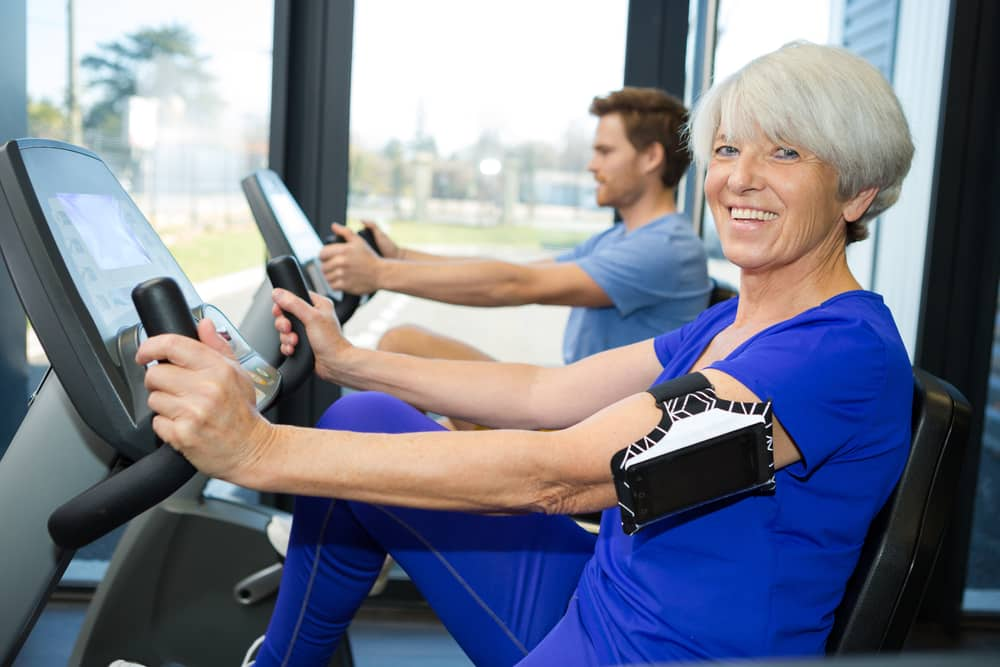Exercise bikes offer a low-impact workout, making them ideal for individuals with arthritis. Strengthening muscles around the knees also improves joint support, relieving some knee pressure and diminishing arthritis-related discomfort.
In this article, we will explore the benefits of exercise bikes and whether they can be an effective way to strengthen the knees.

What Are the Benefits of Using an Exercise Bike to Strengthen Knees?
Cycling benefits knee health because, when executed with the correct form, the pedalling motion strengthens knee-supporting muscles without exerting undue strain, unlike running.
Exercise bikes are frequently employed in knee rehab programs, as they can improve the range of motion and stabilise knee joints. Utilising foot straps can maximise the hamstring workout.
You can modify the bike’s resistance to accommodate your knees’ needs. If the exercise feels too strenuous, simply reduce the resistance. Adding more resistance encourages your muscles to work harder, resulting in stronger, more toned muscles.
However, if you’re dealing with an injury or arthritis, avoid overworking your knees. Instead, gradually increase resistance and alternate between light or no resistance and heavier resistance levels.
Understanding Knee Health
How familiar are you with the intricacies of your knees? Comprehending the complexity of knee anatomy is crucial, as the knee is among the most intricate joints in the human body. The numerous components of the knee make it particularly susceptible to injury.
There are four main elements in your knee: the bones, cartilage, ligaments, and tendons. Cartilage serves as a protective cushion for the bones within the knee. Its slick surface enables the three knee bones to slide effortlessly against one another.
There are two primary forms of cartilage: meniscal and articular. Meniscal cartilage provides stability to the knee, while a tear in this cartilage is a typical knee injury, particularly during twisting or pivoting motions. Articular cartilage facilitates smooth movement between bones when you straighten or bend your leg.

Is Exercise Bike Better than Treadmill for Knees?
Exercise bikes and treadmills are among the most popular workout machines for home and gym use. Both offer effective cardio workouts that build endurance, improve lung capacity and burn calories.
Below is a summary of the 4 key differences between the two to help you decide which is best suited for your fitness goals and lifestyle.
- Treadmills are designed for walking or running indoors and are considered high-impact exercises. On the other hand, stationary bikes simulate cycling and provide lower-impact cardio workouts while delivering a comprehensive cardiovascular workout.
- Treadmills have some advantages, including burning more calories, providing a full-body workout, and offering workout variability through adjustable speed and elevation settings. However, they also pose a higher risk of injury due to the high-impact nature of the workout.
- Stationary bikes offer low-impact exercise, reducing pressure on joints and the risk of injury, making them suitable for those with joint pain or age-related stiffness.
- Exercise bikes are more space-saving compared to treadmills which tend to be bulkier and noisier. Stationary bikes burn fewer calories per minute than treadmills and are less effective at building strong bones due to the lack of weight-bearing exercise.
Note that personal preference plays a role in choosing between these two exercise machines, as enjoyment may lead to longer workout sessions and increased calorie burn.
How to Use Exercise Bikes Safely for Knee Strengthening
Various kinds of exercise bikes exist, but the majority can be categorised as Upright Bike, Recumbent, and Spin. Upright bikes look like traditional outdoor bicycles, featuring smaller seats and pedals located beneath your body.
A recumbent bike comes with larger seats and backrests with pedals situated in front of your body for comfort. Learn more about recumbent bike benefits. Meanwhile, a spin bike includes a flywheel that allows you to stand while pedalling.
- Maintain proper posture.
When using an upright bike, set the seat to around hip height, so you can comfortably reach the handlebars. Keep a slight bend in your knee while pedalling to avoid overextending.
- Secure your footwear to the pedals or opt for clip-in cycling shoes.
- Start with short sessions.
Aim for 20 minutes of biking each day, for three to five days weekly. Break this into shorter intervals if necessary. Begin at a slow pace without resistance. Slowly increase speed and resistance as you get more comfortable.

How to Maintain Knee Health
There are 4 simple ways to maintain knee health. Learn more below.
1. Keeping an Optimal Weight Level
Being overweight or obese can lead to knee discomfort, injuries, and arthritis by adding extra pressure on your knees and increasing inflammation. Weight reduction can help minimise the load on your joints. For each pound lost, stress on your knees is reduced. Keeping a healthy body weight is essential for your overall well-being and knee health.
2. Do Regular Walking or Biking
When the knee cartilage is damaged or worn out, individuals may experience pain, stiffness, and movement difficulties. Low-impact activities such as walking or cycling help restore the joint and strengthen leg muscles. Try to walk or engage in exercise for 30 minutes daily, several times per week, to bolster knee strength.
3. Stretch Your Leg Muscles
Knee pain relief can be achieved by stretching the muscles in your legs. Stretching helps relax muscles, decreases joint stress, and enhances flexibility and mobility. Various stretches should target the quadriceps, hamstrings, calves, hip flexors and adductors, and the iliotibial band.
4. Do Not Ignore Pain
If you encounter knee pain or issues, seek advice from your healthcare provider. Persistent pain or swelling around the knee requires the attention of a medical professional.
Related Questions
Does a stationary bike affect knees?
Using a stationary bike is a low-impact form of exercise that can be beneficial for cardiovascular health and can also help to strengthen leg muscles. When performed correctly, it should not cause any harm to the knees, and may actually help to reduce knee pain and stiffness for some individuals.
What exercise bike is best for bad knees?
When it comes to choosing an exercise bike for bad knees, there are a few factors to consider. First, you’ll want to look for a bike that has a comfortable seat and is adjustable to your body size and shape. Additionally, you may want to consider a bike with a recumbent design, which can take pressure off the knees and back.
- How Long Should You Stay in a Sauna Safely? - 20 January 2024
- Boost Post-Workout Recovery: Benefits of Using a Sauna for Recovery - 19 January 2024
- Discover the Health Benefits of a Low EMF Infrared Sauna - 19 January 2024
